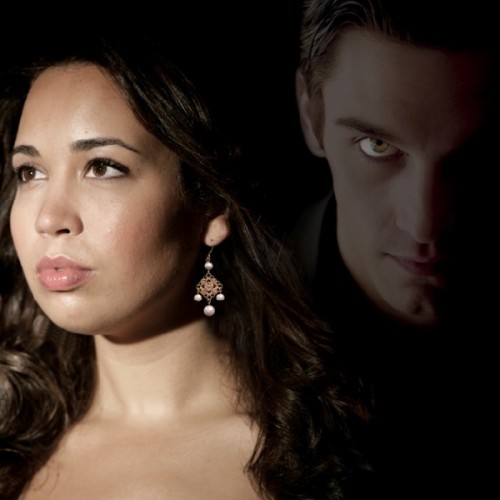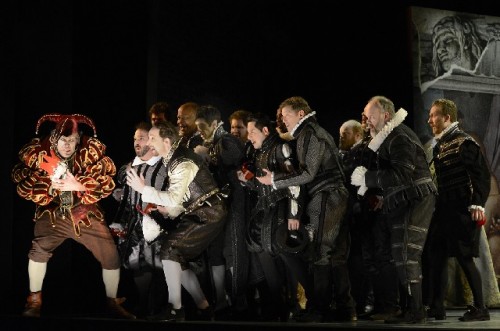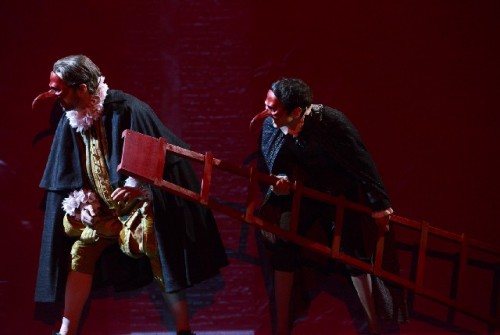Nadine Sierra Triumphs with Boston Lyric
Verdi Masterpiece Stylishly but Traditionally Staged
By: David Bonetti - Mar 19, 2014
Rigoletto
Music by Giuseppe Verdi
Libretto by Francesco Maria Piave
Premiered at La Fenice in Venice in 1851
Boston Lyric Opera
A co-production of Boston Lyric Opera, The Atlanta Opera and Opera Omaha
Shubert Theatre, Boston
March 14 to 23, 2014
Conductor: Christopher Franklin
Stage Director: Tomer Zvulun
Set Designer: John Conklin
Costume Designer: Victoria Tzykun
Lighting Director: Robert Wierzel
Cast: Rigoletto, Michael Mayes; the Duke of Mantua, Bruce Sledge; Gilda, Nadine Sierra; Sparafucile, Morris Robinson; Maddalena, Audrey Babcock; Count Monterone, David Cushing; Marullo, David Kravitz; Countess Ceprano, Chelsea Basler; Count Ceprano, Liam Moran; Borsa, Omar Najmi; Giovanna, Samantha Weppelmann; The Duchess of Mantua, Vanessa Schukis; Usher, Ron Williams
Over the past half-century opera goers have gotten used to seeing operas set in times and places other than what their creators intended. When Peter Sellars, for instance, set Handel’s “Julius Caesar in Egypt” around the pool of the Cairo Hilton or Mozart’s “The Marriage of Figaro” in the then-new Trump Tower the switches were provocative, and they (sometimes) made sense. But by now, the practice has become as tired a convention as the traditional productions they displaced were then. There are still some inspired updatings – the Met’s recent setting of “Rigoletto” in Rat Pack-era Las Vegas, for instance, a very good example. But there have been some fruitless reimaginings – the Boston Lyric Opera’s transplanting of Mozart’s “The Magic Flute” from ancient Egypt to contemporary Yucatan, for instance, added nothing to the Masonic-informed fairy-tale while losing much of its weird charm.
So it was good news, at least to this critic, that this time the BLO stayed close to the source for its version of “Rigoletto.” Verdi set the melodrama about a hunchback jester and his innocent daughter at the corrupt court of the Duke of Mantua, and that is where the current production remains. Being traditional doesn’t mean being dull. What is more potentially gorgeous than an opera featuring a late Renaissance court filled with courtiers in fancy dress and the great art that decorated their scenes of decadence?
Fortunately, the production team, led by stage director Tomer Zvulun and costume designer Victoria Tzykun, both in their company debuts, and, as set designer, BLO regular John Conklin– he was responsible for the unhappy “Magic Flute” - were up for the task and created a smart, often beautiful production. Indeed, it was probably the most successful BLO-created production I’ve seen in the four seasons I’ve been covering opera in Boston. Maybe the company should stick to the basics in the future, leaving deviations from tradition to the occasions when it has a truly inspired idea.
The stage picture was divided in horizontally. Above, was a white replica of the ideal Renaissance city derived by a painting by Piero della Francesca. Below, the reality. Fragmented murals inspired by the murals Giulio Romano painted for the real Duke of Mantua, Federigo Gonzaga, for his Mannerist pleasure palace, Il Palazzo del Te, on the outskirts of Mantua, decorate the Duke’s decadent court. Tzykun’s costumes are traditional. The courtiers, the “vil razza dannata” (damned race) of Rigoletto’s famous denunciation, are all dressed in variations of basic black, chic and elegant. The hunch-backed jester – sorry, the opera, based on a play by Victor Hugo, was written before p.c. censorship kept us from using such terms – sports the traditional jester’s costume of floppy three-peaked cap, each ending with bells, and rattle. Gilda, Rigoletto’s virginal daughter, just three-months out of convent school, wears the chaste dresses of an innocent. The Duke, well, he is dressed as a Renaissance Duke.
The color scheme is largely black and red - Gilda and an occasional other character, like the dignified Duke Monterone, in white - and red scrims descend frequently to isolate characters both in front of and behind it to great effect. It was most effective in the final scene when Gilda, who has been murdered by the “bravo” Sparafucile in place of the Duke who deflowered her and placed in a bag ready to be dumped in the river, is discovered by Rigoletto - who had paid Sparafucile to kill the Duke, not his daughter - and in their final great duet, a weird twist on the traditional love-death that ends so many operas, Gilda, already an angel, sings from behind the red scrim, walking slowly off stage as she dies, while her father sings to a dummy in the body bag. A brilliant theatrical conceit.
Robert Wierzel’s lighting added to the overall effect, although whoever was manning the lights the afternoon I saw the opera was shaky and slow to move the lights, undercutting his intentions. Wierzel adopted the chiaroscuro (contrast of lights and darks) from Baroque paintings that make them so dramatic. One of his best moments was in the small scene in which Gilda is rescued from a group of courtiers by her father. The brief scene, at the back of the stage, in which forms were picked out of shadow by the lights, looked like a painting by Caravaggio or his Burgundian follower Valentin de Boulogne.
The story of “Rigoletto” is so well known to opera lovers that it doesn’t require much summary here. It is a melodrama, a category of drama much derided, for largely good reasons, in the post-modern world. But where the melodramas that dominated the 19th century stage have long been forgotten, including the Victor Hugo source of the opera, “Le Roi S’amuse” (The King Amuses Himself), Verdi’s endures largely because his musical genius transcended its source. “Rigoletto” is the first of Verdi’s masterpieces, coming after a long line of what he called his journeyman work, all of which had their moments but ultimately reflected the low dramatic standards of its time.
Briefly: The hunch-backed Rigoletto is jester at the court of the corrupt Duke of Mantua, his deformity mirroring the ethical deformity of the court. He is particularly cruel, his wit, if you can call it that, based on deriding other members of the court, especially those who have suffered at the hands of the lascivious Duke. Duke Monterone, come to save his daughter from degradation – the staging graphically shows her
being passed from courtier to courtier after the Duke has disposed of her – hurls a curse at Rigoletto, who has taunted him in his moment of distress. Rigoletto shrivels as the act ends – a father being cursed by another father who has lost his daughter to rape. How the curse plays out is so central to the opera’s action that Verdi originally planned to title the work “La maledizione” (The Curse).
In the next scene we are introduced to Gilda, Rigoletto’s daughter, who has been kept as a virtual prisoner in their home since she has returned from convent school, going out only to church, chaperoned by her maid. The Duke has taken a liking to her – she is young, beautiful and a virgin – and has infiltrated the house while Rigoletto is not looking. Gilda falls in love and sings a rapturous aria (“Caro nome”) to his (false) name that expresses innocent love better than almost anything in the entire opera literature. The courtiers have been plotting, however, and kidnap the girl they think is Rigoletto’s mistress. They bring her to the Duke, who has his way with her. Rigoletto shows up at court, a defeated man, to save his daughter. In one of the great arias in an opera full of them, he curses the courtiers (“Cortigiani, vil razza dannata”) and then falls to his knees to beg them to return Gilda to him. She breaks away, he brings her home, but she insists that she still loves the Duke whatever he might have done to her.
The scene switches to an inn on the outskirts of town, where Sparafucile, the murderer for hire, lives with his sister Maddalena, who, like Homer’s Sirens, lures men to their deaths. Rigoletto pays Sparafucile to kill the Duke, but Gilda substitutes herself for the Duke and is killed in his place - I told you it was a melodrama! When Rigoletto discovers that he has basically paid to have his beloved daughter killed, he cries out “la maledizione!” as the opera ends.
The final act includes two of the miracles of Romantic opera, one simple, one complex. The Duke’s ditty, “La donna è mobile” (Woman is fickle), despite its profound misogyny, is one of the most infectious tunes in opera. And the great quartet, “Bella figlia del’amore” (Beautiful daughter of love), is one of the best examples in opera of how four people, each singing his or her own very different thoughts, can produce an ensemble that is melodically and harmonically cohesive.
The character of a corrupt, sexually insatiable Duke is largely indebted to Mozart’s “Don Giovanni,” which was only 60 years old when Verdi wrote “Rigoletto,” about as old to him and his audiences as Stravinsky’s “The Rake’s Progress” is to ours. Indeed, the background music in the opening scene of the court, teeming with courtiers and their busyness, is reminiscent of the famous minuet Mozart wrote for his masterpiece. But there are crucial differences as well. As morally bankrupt as Mozart’s Don was – after all, the opera opens with him killing the elderly father of a woman he has seduced and ends with him being swallowed up into the mouths of Hell – he was basically a lover of women. Verdi’s Duke hates women, seeing them only as a momentary portal to his personal pleasure and then as something to be discarded. We have moved from the old world to the new, and we’re still struggling with the moral landscape Verdi and his peers created. Except today, women fight back. (But so did Donna Anna, if not the hapless Gilda.)
But enough of this! What a bad critic I am, ruminating on ethics and changing mores, not to mention production values, recapitulating a plot you can find at the flick of a finger on Wikipedia. What you want to know is how the singers were. And you would be right. If Gilda cannot hit the high notes what does it matter that her innocence be betrayed?
As Gilda, Nadine Sierra was as good a Gilda as you can hear today on the opera stage. Young – she is only 25 – beautiful and blessed with a gorgeous, silvery soprano that is perfect for the role, she was perfect for the role. Her beautiful singing brought out the essential bel canto quality of the role as Verdi, looking back at the same time he was looking forward, wrote it. Sierra negotiated her high notes with ease and moved through the different vocal registers effortlessly. In “Caro nome,” her moment in the spotlight, she made time stop in a descending run of notes, each etched in silver.
All the more sad it is to also report that the one egregious directorial decision was to have her sing much of that great aria on her back on the floor, a 1980s cliché that should be retired by all opera directors - immediately. Who sings a rapturous aria to one’s beloved while lying on one’s back in a walled courtyard? No one, is the answer, not now, not then. In such a self-consciously traditional production why not have her step to the lip of the stage and sing the beautiful melody directly to the audience as divas of the past did? What a pleasure it would have been for us to hear her at the height of her vocal maturity share the beauty of her voice with those assembled and what a pleasure it would have been for her to share her gift. But, no, she sang from her back, and the minute she assumed that ridiculous position, the volume of her voice diminished. The production is going on to Atlanta and Omaha - perhaps the director will correct his one mistake, a big one, before then.
Sierra sang with the BLO once before as Tytania in Benjamin Britten’s “Midsummer Night’s Dream.” She was outstanding in a badly conceived production, also by John Conklin. The BLO makes an admirable attempt to cultivate young singers. Let’s hope they use Sierra again before the big houses pick her up and she becomes unavailable for the Boston/Atlanta/Omaha circuit. In an Opera News interview she said she looked forward to singing Puccini’s Mimi. She will sing Musetta, the second soprano role in “La Boheme” with San Francisco Opera this coming season. Maybe the BLO should give her the opportunity to sing Mimi here. It will be to both her and its advantage – not to mention the audience’s pleasure.
It would be nice to report that the rest of the cast sang at Sierra’s level. As Sparafucile, bass Morris Robinson did. His Italian enunciation was noteworthy, and his rumbling low notes were exciting. Indeed, his first exit brought forth the first ovation from the house.
As the Duke, tenor Bruce Sledge, who sings at major houses like the Met and Covent Garden, was good, but he lacked the ringing tone, the famous Italianate ping, that gets the crowds cheering.
In his first outing in the challenging title role, baritone Michael Mayes was totally committed dramatically to communicating Rigoletto’s profoundly conflicted nature, at once the loving father of an orphaned child and the cruel, sadistic jester at a libertine’s court. But the role was vocally too much for him at this stage of his career, which has been devoted to slight stuff by composers like Jaek Heggie. His voice was rough and too often his pitch was wayward. Overall, his performance was moving, but it was not vocally persuasive, which it has to be for the production to be fully successful. Mayes is young. Rigoletto is the role of a lifetime for a baritone. With luck he will grow into it. He demonstrated that he understood the character. Now he has to learn how to sing him. I’m betting that he will.
Most of the smaller roles were well sung. A special shout-out to baritone David Kravitz, as the courtier Marullo, who is proving himself to be indispensable in local productions. Maybe someday he should be given the opportunity to take on the role of Rigoletto. I suspect he is ready.
In the pit, conductor Christopher Franklin played the overture slowly and deliberately, holding back until the cymbals announced that the melodrama was about to start. Throughout, he varied the beat according to what what happening on stage, accommodating himself to the needs of his singers. An auspicious company debut.






